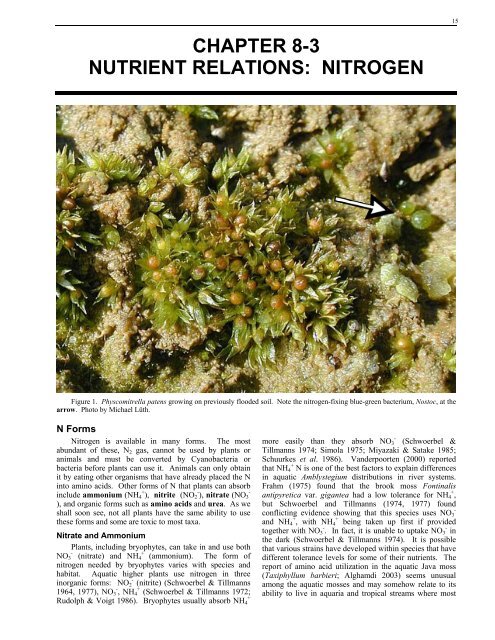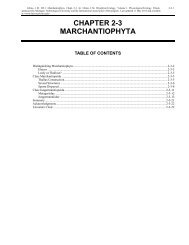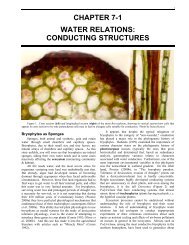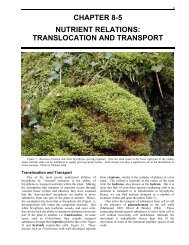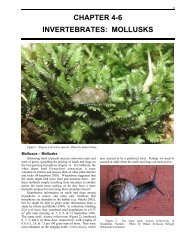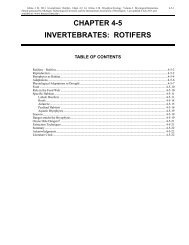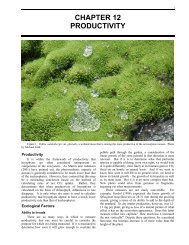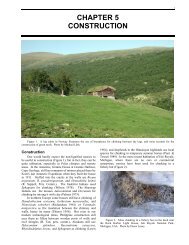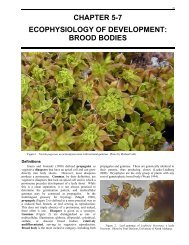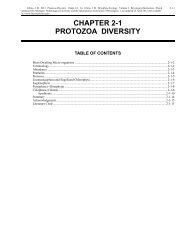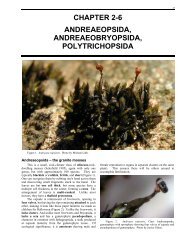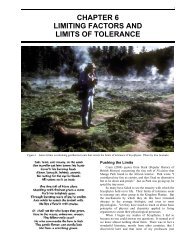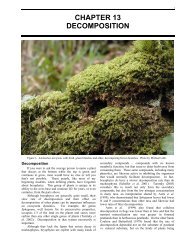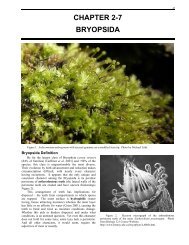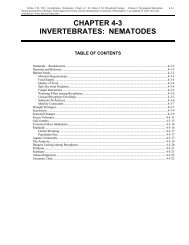chapter 8-3 nutrient relations: nitrogen - Bryophyte Ecology ...
chapter 8-3 nutrient relations: nitrogen - Bryophyte Ecology ...
chapter 8-3 nutrient relations: nitrogen - Bryophyte Ecology ...
You also want an ePaper? Increase the reach of your titles
YUMPU automatically turns print PDFs into web optimized ePapers that Google loves.
CHAPTER 8-3<br />
NUTRIENT RELATIONS: NITROGEN<br />
Figure 1. Physcomitrella patens growing on previously flooded soil. Note the <strong>nitrogen</strong>-fixing blue-green bacterium, Nostoc, at the<br />
arrow. Photo by Michael Lüth.<br />
N Forms<br />
Nitrogen is available in many forms. The most<br />
abundant of these, N2 gas, cannot be used by plants or<br />
animals and must be converted by Cyanobacteria or<br />
bacteria before plants can use it. Animals can only obtain<br />
it by eating other organisms that have already placed the N<br />
into amino acids. Other forms of N that plants can absorb<br />
include ammonium (NH4 + ), nitrite (NO2 - ), nitrate (NO3 -<br />
), and organic forms such as amino acids and urea. As we<br />
shall soon see, not all plants have the same ability to use<br />
these forms and some are toxic to most taxa.<br />
Nitrate and Ammonium<br />
Plants, including bryophytes, can take in and use both<br />
NO3 - (nitrate) and NH4 + (ammonium). The form of<br />
<strong>nitrogen</strong> needed by bryophytes varies with species and<br />
habitat. Aquatic higher plants use <strong>nitrogen</strong> in three<br />
inorganic forms: NO2 - (nitrite) (Schwoerbel & Tillmanns<br />
1964, 1977), NO3 - , NH4 + (Schwoerbel & Tillmanns 1972;<br />
Rudolph & Voigt 1986). <strong>Bryophyte</strong>s usually absorb NH4 +<br />
more easily than they absorb NO3 - (Schwoerbel &<br />
Tillmanns 1974; Simola 1975; Miyazaki & Satake 1985;<br />
Schuurkes et al. 1986). Vanderpoorten (2000) reported<br />
that NH4 + N is one of the best factors to explain differences<br />
in aquatic Amblystegium distributions in river systems.<br />
Frahm (1975) found that the brook moss Fontinalis<br />
antipyretica var. gigantea had a low tolerance for NH4 + ,<br />
but Schwoerbel and Tillmanns (1974, 1977) found<br />
conflicting evidence showing that this species uses NO3 -<br />
and NH4 + , with NH4 + being taken up first if provided<br />
together with NO3 - . In fact, it is unable to uptake NO3 - in<br />
the dark (Schwoerbel & Tillmanns 1974). It is possible<br />
that various strains have developed within species that have<br />
different tolerance levels for some of their <strong>nutrient</strong>s. The<br />
report of amino acid utilization in the aquatic Java moss<br />
(Taxiphyllum barbieri; Alghamdi 2003) seems unusual<br />
among the aquatic mosses and may somehow relate to its<br />
ability to live in aquaria and tropical streams where most<br />
15
16 Chapter 8-3: Nutrient Relations: Nitrogen<br />
other bryophytes seem unable to survive. Could this in<br />
some way relate to the higher annual temperatures of its<br />
tropical habitat?<br />
Assuming that bryophytes operate as do tracheophytes,<br />
NO3 - , once in the plant, is converted to NH4 + . In leaves,<br />
the intermediate product, NO2 - , is reduced by nitrite<br />
reductase (an enzyme that facilitates the addition of<br />
hydrogen and loss of oxygen from NO2 - during the<br />
photosynthetic electron transport process). No intermediate<br />
product is released and the final product is NH4 + . Since<br />
photosynthesis provides the NADH (nicotinamide adenine<br />
dinucleotide, the active coenzyme form of vitamin B3) and<br />
ferredoxin needed for conversion of <strong>nitrogen</strong> oxides to<br />
NH4 + , the conversion process is enhanced by the same<br />
things that enhance photosynthesis – high light and warm<br />
temperatures (Salisbury & Ross 1978). Thus, more<br />
ammonium is produced.<br />
nitrite reductase<br />
NO3 - → NO2 - → NH4 +<br />
nitrate nitrite ammonium<br />
Brown (1982) suggested that the pH or alkalinity<br />
affects availability of N for plants, with NO3 - being more<br />
available in neutral or alkaline soils and NH4 + in acidic<br />
soils and water. But NH4 + is usually toxic to plants in any<br />
appreciable quantity. Sironval (1947) found that NH4 + ions<br />
caused degeneration of the caulonema of Funaria<br />
hygrometrica and Southorn (1977) found they caused<br />
morphological abnormalities in the same species. Killian<br />
(1923) likewise found morphological abnormalities in the<br />
leafy liverwort Scapania. On the other hand, Burkholder<br />
(1959) found that cultured bryophytes did equally well on<br />
both NO3 - and NH4 + salts. An interesting consequence of<br />
pH differences was suggested by Machlis (1962). In<br />
Sphaerocarpos texanus, male plants are smaller than<br />
females in the field. Machlis attributed this to the ability of<br />
male plants to absorb NH4 + ions more readily than females,<br />
causing them to have a lower pH, which could suppress<br />
growth. He supported this suggestion by growing the<br />
plants on potassium, which caused no pH change, and<br />
likewise no reduction in the size of male plants.<br />
In a study designed to determine the effects of various<br />
forms of N on bryophyte function, Alghamdi (2003)<br />
studied the popular, fast-growing aquarium moss<br />
Taxiphyllum barbieri (Java moss). He found that the<br />
benefit to the moss depends on what parameter you<br />
measure (Figure 2). For example, dry biomass increase<br />
was greatest in high NO3 - concentrations (30 mg/L N),<br />
whereas the greatest increase in length occurred in high<br />
NH4 + concentrations (30 mg/L N). This difference resulted<br />
in the least biomass increase per stem length in high NH4 +<br />
concentrations, despite the relatively high increase in<br />
length in that treatment. The overall appearance of the<br />
mosses in high NH4 + , then, was to appear long and thin<br />
compared to those in other treatments, but not dissimilar to<br />
the plants in the control (standard <strong>nutrient</strong> solution but with<br />
no N source). Based on the lower growth in the NH4NO3<br />
media, Alghamdi reasoned that in the presence of NH4 + , the<br />
NO3 - became unusable because of the inhibition of nitrate<br />
reductase by NH4 + . At the same time, the lower<br />
concentration of NH4 + (15 mg/L N) in combination<br />
compared to NH4 + alone (30 mg/L N) reduced the growth.<br />
This <strong>relations</strong>hip was consistent with much greater growth<br />
at 30 mg/L N than at 10 mg/L N as NH4 + (Figure 2).<br />
Figure 2. Effects of various forms of inorganic N (control =<br />
no N, NO2 - = nitrite, NO3 - = nitrate, NH4 + = ammonium) on<br />
growth in length and biomass of Taxiphyllum barbieri. Box mean<br />
(dot) and median (horizontal line); bottom of box is first quartile<br />
and top is third quartile. Whiskers represent lowest and highest<br />
observations still inside region defined by lower limit Q1 - 1.5<br />
(Q3 - Q1) and upper limit Q3 + 1.5 (Q3 - Q1); * represents<br />
outliers that extend beyond the whiskers; n = 15 sets of 3 stems.<br />
Means with same letters are not significantly different from each<br />
other (DNMRT, α = 0.05). Based on Alghamdi (2003).<br />
NO2 - caused only modest improvements in biomass<br />
and length over the N-free controls (Figure 2), but caused<br />
considerable increase in chlorophyll a (Alghamdi 2003;<br />
Figure 3). The chlorophyll a:b ratio was highest in the high<br />
NO3 - treatment, due to mosses in that treatment having the<br />
least chlorophyll b per biomass of moss, a concentration<br />
even lower than that of the controls (Figure 3). In fact, the<br />
effects of inorganic N form on chlorophyll b resulted in<br />
either no improvement over N-free controls, or depressed<br />
levels of chlorophyll b. Chlorophyll a, on the other hand,<br />
was higher in nearly all the <strong>nitrogen</strong> treatments than in the<br />
controls. Baxter et al. (1992) found a similar but slight<br />
decrease in total chlorophyll concentration in Sphagnum<br />
cuspidatum, typically a submersed species, with increasing<br />
levels of NH4 + , but in Alghamdi's experiments,
Taxiphyllum barbieri actually had a total chlorophyll<br />
increase, although not statistically significant, with an<br />
increase from 1 to 30 mg/L N as NH4 + (Figure 3).<br />
Protein concentrations in Taxiphyllum barbieri showed<br />
a very different picture from other measurements, with<br />
little difference among treatments except at 10 and 30 mg/L<br />
NO3 - (Figure 3; Alghamdi 2003). In Sphagnum cuspidatum<br />
the addition of NH4 + (as NH4Cl) generally caused an<br />
increase in amino acids, at least within the first 15 days, in<br />
both locations studied, with arginine increasing the most. at<br />
the unpolluted site and actually decreasing at the NH4 + -<br />
polluted site (Baxter et al. 1992). The latter study suggests<br />
that Sphagnum cuspidatum may acclimate to a higher level<br />
of NH4 + in a way that it eventually requires higher levels<br />
than populations not continuously exposed to such high<br />
levels. Clearly the uses of the various forms of N in<br />
bryophytes are complex and one cannot give a simple<br />
answer as to which form is best.<br />
Figure 3. Effects of various forms of inorganic N (control =<br />
no N, NO2 - = nitrite, NO 3 - = nitrate, NH4 + = ammonium) on<br />
chlorophyll a and protein concentrations of Taxiphyllum barbieri.<br />
Notation as in Figure 2; n = 15 sets of 3 stems. Based on<br />
Alghamdi (2003).<br />
In Sphagnum, differences exist among the species.<br />
Sphagnum flexuosum is apparently unable to utilize NO3 -<br />
(Schuurkes et al. 1986), and Touffet (1971) found that<br />
NO3 - actually reduced the growth of Sphagnum and was<br />
less effectively utilized than NH4 + when it was the only N<br />
resource. Nevertheless, in many Sphagnum species nitrate<br />
reductase, an inducible enzyme (Deising 1987), permits use<br />
of NO3 - . High levels of NH4 + inhibit nitrate reductase, and<br />
hence reduce growth, by inhibiting NO3 - uptake (Rudolph<br />
et al. 1987). Rudolph and Voigt (1986) demonstrated that<br />
322 µM was a favorable concentration of NO3 - in<br />
Sphagnum magellanicum, whereas at 225 µM NH4 + the<br />
chlorophyll content decreased. At 600 µM NH4 + , the<br />
nitrate reductase activity was reduced up to 20%. These<br />
factors most likely contribute to the location of mosses in<br />
their particular habitats by defining their <strong>nutrient</strong> niches.<br />
Chapter 8-3: Nutrient Relations: Nitrogen 17<br />
Organic Nitrogen<br />
Most agricultural plants seem to absorb their <strong>nitrogen</strong><br />
in the form of NH4 + or NO3 - , but it seems that bryophytes<br />
have more options. Sphagnum is able to use urea (along<br />
with phosphate) in the Alaskan wetlands, resulting in an<br />
increase in biomass compared to controls (Sanville 1988).<br />
In nature, amino acids likewise can be abundant, present as<br />
breakdown products of plant and animal wastes and litter.<br />
Yet few culture studies or field tracer studies have included<br />
these organic forms. Is it possible that bryophytes can use<br />
this organic N as their primary source? If so, they may<br />
benefit from organic leachates in early stages of litter<br />
decomposition of a soil environment.<br />
In bogs and poor fens, NH4 + seems to be the<br />
predominant form of available N (Rosswall & Granhall<br />
1980). NO3 - is often lost through denitrification (Hemond<br />
1983). Not surprisingly, some studies show that Sphagnum<br />
seems to require most of its inorganic N as NH4 +<br />
(Schuurkes et al. 1986). But Simola (1975, 1979) showed<br />
that Sphagnum nemoreum and S. fimbriatum both could use<br />
amino acids. Sphagnum nemoreum grows almost as well<br />
on the amino acids arginine and alanine as on NH4 + salts,<br />
but it is unable to use leucine, lysine, or methionine<br />
(Simola 1975). More recently, McKane (1993), using<br />
tracer studies, found that for Sphagnum, Aulacomnium<br />
palustre, and Hylocomium splendens, the amino acid<br />
glycine was actually the preferred form of <strong>nitrogen</strong> over<br />
NH4 + and NO3 - .<br />
It appears that in Arctic ecosystems, organic <strong>nitrogen</strong><br />
(amino acids, especially glycine) may actually be the<br />
preferred source of N for some bryophytes, including<br />
Sphagnum rubellum (Kielland 1997). Even amino acids<br />
with higher molecular weights, such as aspartate and<br />
glutamate, can be absorbed at higher rates than inorganic<br />
N. Kielland suggested that the high capacity for absorbing<br />
amino acids might be an adaptation to the low inorganic N<br />
availability in the Arctic.<br />
Even floodplain bryophytes can use amino acids.<br />
Schuler et al. (1955) found that in culture the thallose<br />
liverwort Sphaerocarpos texanus grew more typically on a<br />
mix of amino acids than it did on NH4NO3 alone.<br />
Brown (1982) suggested that in low N environments<br />
the mosses may be able to move organic molecules<br />
containing N from dying and dead cells to the growing<br />
apex. It is very likely that these molecules would be amino<br />
acids, as well as dipeptides and other organic compounds.<br />
Burkholder (1959) examined the effects of 20 amino<br />
acids (0.0001 M AA to 0.0016 M AA with and without the<br />
addition of NH4NO3 on the color and growth of Atrichum<br />
undulatum. Glycine, L-cystine, L-cysteine, and Ltyrosine<br />
were the only treatments with amino acids alone<br />
in which the moss retained its green color. Others were<br />
yellow-green, brown-green, or brown (DL-serine and DLtryptophan).<br />
When grown in combination of each of these<br />
20 amino acids with NH4NO3, plants in all treatments grew<br />
more than in any of the amino acids alone except in the<br />
highest concentration (0.0016 M) of DL-tryptophan.<br />
Growth was generally greatest in the lower concentration<br />
of amino acid (0.0001 M) plus NH4NO3.<br />
Alghamdi (2003) chose common soil water-soluble<br />
amino acids (glycine, methionine, serine, arginine, and<br />
alanine) to compare their effects on growth, branching,<br />
chlorophyll, and protein on Taxiphyllum barbieri. He
18 Chapter 8-3: Nutrient Relations: Nitrogen<br />
found that four of these amino acids induced branching,<br />
relative to the controls, but no branching appeared in any of<br />
the methionine treatments (Figure 4).<br />
Figure 4. Effects of water soluble amino acids on number of<br />
branches in the Java moss, Taxiphyllum barbieri. cont = control,<br />
gly = glycine, meth = methionine, ser = serine, arg = arginine,<br />
ala = alanine. From Alghamdi (2003).<br />
Figure 5. Effect of water soluble amino acids on the<br />
biomass, length, and robustness (wt:length) of the Java moss,<br />
Taxiphyllum barbieri. Cont = control, Gly = glycine, Meth =<br />
methionine, Ser = serine, Arg = arginine, Ala = alanine. Length<br />
and biomass represent sum of 3 stems; n = 10 sets of 3 stems.<br />
Notation as in Figure 2. Based on Alghamdi (2003).<br />
Methionine proved to be inhibitory to growth in<br />
length whereas serine caused an increase in both dry<br />
biomass and length relative to controls (Figure 5; Alghamdi<br />
2003). Arginine as the only N source at 1, 10, and 30<br />
mg/L caused a striking increase in the biomass and ratio of<br />
dry biomass to length, but maintained a length somewhat<br />
less than that of the N-free controls (Figure 5). This<br />
resulted in unusually short, wide plants, combined with<br />
high protein concentrations but below normal chlorophyll<br />
concentrations at the lowest level applied (1 mg/L; Figure<br />
6).<br />
Methionine likewise caused an increase in biomass<br />
and decrease in length growth with concentration increase<br />
(1, 10, 30 mg/L). Alanine caused an increase in both<br />
length and biomass with concentration, with the overall<br />
effect being one of a more robust plant at higher<br />
concentrations, having a higher biomass to length ratio than<br />
that of the controls. The mosses responded to 1 mg/L<br />
glycine much as they did to the N-free medium, but at<br />
higher concentrations (20 and 30 mg/L) their length and<br />
biomass both increased considerably over that of controls.<br />
Figure 6. Effect of water soluble amino acids on the protein<br />
content and total chlorophyll concentration of the Java moss,<br />
Taxiphyllum barbieri. cont = control, gly = glycine, meth =<br />
methionine, ser = serine, arg = arginine, ala = alanine. n = 10 sets<br />
of 3 stems. Notation as in Figure 2. From Alghamdi (2003).<br />
Alghamdi (2003) then compared the effects of glycine,<br />
which seemed to produce the "healthiest" plants, to those of<br />
the inorganic forms of N. This aquatic moss did less well<br />
on the inorganic forms NH4NO3 or NO3 - than on NH4 +<br />
alone or NH4 + + the amino acid glycine and did best on<br />
glycine alone, producing more biomass, longer stems, and<br />
more branches (Figure 7, Figure 8). In fact, glycine<br />
seemed to induce branching (Table 1).<br />
In the same series of experiments, Alghamdi (2003)<br />
examined the effects of inorganic N and glycine on the<br />
chlorophyll and protein content. Glycine, both alone and in<br />
combination with NH4 + , resulted in the highest protein<br />
concentrations (Figure 9). The effects on chlorophyll were<br />
less clear, but the highest total chlorophyll occurred in the<br />
highest glycine concentration. NH4 + at 20 mg/L, however,<br />
produced similar chlorophyll concentrations, but at 30<br />
mg/L the chlorophyll content decreased.
Figure 7. Effect of N source as nitrate (NO 3 + ), ammonium<br />
(NH4 + ), glycine (gly), and combinations at two concentrations on<br />
number of branches in Taxiphyllum barbieri. The combinations<br />
have half the total N from each source. From Alghamdi (2003).<br />
Figure 8. Effect of nitrate (NO 3 + ), ammonium (NH4 + ),<br />
glycine (gly), and combinations on the increase in biomass and<br />
length and robustness (wt:length) of the Java moss, Taxiphyllum<br />
barbieri. Notation as in Figure 2; n = 10 sets of 3 stems. From<br />
Alghamdi (2003).<br />
Other organic compounds, such as nucleic acids, are<br />
also released from organism tissues as they decay. Based<br />
his data showing that Atrichum undulatum had good<br />
Chapter 8-3: Nutrient Relations: Nitrogen 19<br />
growth in a medium with yeast nucleic acids as its N<br />
source, Burkholder (1959) tested growth of this species on<br />
the nucleic acid bases. Growth of leafy shoots was good in<br />
adenine and guanine, but there was no growth in uracil or<br />
thymine. Growth in xanthine, uric acid, and cytosine was<br />
less than that in NH4NO3. Both uracil (in the presence of<br />
NH4NO3) and aspartic acid caused Sphagnum squarrosum<br />
to become thalloid (resembling its protonema), as did<br />
hydroxyproline + glycine, occasionally (Burkholder 1959).<br />
Not all mosses responded in the same way. Growth of<br />
Leptobryum pyriforme and Splachnum sphaericum and<br />
others was "excellent" on a medium with NH4NO3 plus<br />
uracil, but was poor in Sphagnum squarrosum. On the<br />
other hand, while growth of Leptobryum pyriforme was<br />
good with uric acid and cytosine, Splachnum sphaericum<br />
had poor growth. The ability to use nucleic acids, amino<br />
acids, and other organic N compounds could permit<br />
bryophytes to take advantage of partially decomposed litter<br />
in which these <strong>nitrogen</strong> sources leak from the dead tissues.<br />
Table 1. Effect of various N forms on moss branching in<br />
Taxiphyllum barbieri. From Alghamdi (2003).<br />
Treatment Moss Branching<br />
glycine long with many short branches<br />
NO3 - short and no branches<br />
NH4 + long and few short branches<br />
glycine +<br />
NH4 +<br />
NH4NO3<br />
long with many short branches and<br />
slightly thin<br />
short, thin and few short branches<br />
Figure 9. Effects of inorganic N compared to glycine on the<br />
protein and chlorophyll content of Java moss (Taxiphyllum<br />
barbieri). Notation as in Figure 2; n = 10 sets of 3 stems. From<br />
Alghamdi (2003).
20 Chapter 8-3: Nutrient Relations: Nitrogen<br />
Amino acids, leaking into the environment, could<br />
cause developmental anomalies leading to abnormal<br />
growth forms in bryophytes. Some amino acids, such as<br />
hydroxyproline, can cause desuppression in the<br />
development of underleaves in liverworts (Basile & Basile<br />
1980; Basile et al. 1988), causing them to look like normal<br />
leaves. In Atrichum, amino acids inhibited leafy shoot<br />
development (Burkholder 1959). This might be another<br />
example of the Gaia hypothesis (Lovelock, 1988), wherein<br />
the ecosystem behaves like a superorganism and species<br />
depend on other species for their biochemical needs during<br />
development.<br />
Nitrogen Fixation<br />
With 78% of our atmosphere being composed of<br />
<strong>nitrogen</strong> and only about 5% of biomass being <strong>nitrogen</strong>, one<br />
would expect this element to be no problem for living<br />
systems to obtain. But unlike phosphorus, it cannot<br />
normally be obtained from bedrock. And just as you and I<br />
can make no use of the free, gaseous <strong>nitrogen</strong> we breathe,<br />
most plants can't either. Instead, plants require their<br />
<strong>nitrogen</strong> fixed into ammonium (NH4 + ) or nitrate (NO3 - )<br />
salts (or converted to amino acids) before they can obtain<br />
and convert it to specific amino acids and proteins they<br />
need. Nitrogen fixation is the process of trapping<br />
atmospheric <strong>nitrogen</strong> and converting it to NH4 + and in<br />
some cases, converting it to NO3 - .<br />
Nitrogen fixation is a major source of usable <strong>nitrogen</strong>,<br />
particularly in bogs and fens. Like many tracheophytes,<br />
bryophytes can use N released by N fixation from<br />
associated bacteria and Cyanobacteria. The heterocysts<br />
(Figure 10) of Cyanobacteria make them a rich source of<br />
amino acids as a result of their <strong>nitrogen</strong>-fixing activity.<br />
That is, they are able to convert atmospheric N to a form<br />
usable by other living organisms.<br />
Figure 10. Anabaena (Cyanobacteria) showing heterocyst in<br />
middle lower part of picture. Photo by Janice Glime.<br />
In the process of <strong>nitrogen</strong> fixation in Cyanobacteria,<br />
the simple CH2O group from sugars, fixed by cells adjacent<br />
to the heterocyst, is moved into the heterocyst (Figure 11).<br />
Atmospheric <strong>nitrogen</strong> (N2) enters adjacent cells and is<br />
passed to the heterocyst. In the heterocyst <strong>nitrogen</strong><br />
reductase (enzyme that catalyzes addition of H + to N to<br />
form NH4 + ) catalyzes the transformation of N2 to the<br />
reduced NH4 + with H + obtained from the CH2O group.<br />
Figure 11. Nitrogen fixation in Cyanobacteria, with<br />
atmospheric <strong>nitrogen</strong> entering an adjacent cell and being<br />
transferred to the heterocyst, where it is converted to ammonium<br />
(NH4 + ). The ammonium is then moved to the adjacent cell where<br />
it is converted into organic compounds, typically amino acids.<br />
Diagram by Janice Glime.<br />
Many studies have shown that some bryophytes,<br />
especially peatland bryophytes, obtain N through N<br />
fixation processes of surface-dwelling Cyanobacteria as<br />
well as other bacteria (Cullimore & McCann 1972;<br />
Granhall & Selander 1973; Alexander et al. 1974; Basilier<br />
et al. 1978; Smith & Ashton 1981; Smith 1984; Nakatsubo<br />
& Ino 1986, 1987; Bentley 1987; Given 1987; Bergman et<br />
al. 1993; Madhusoodanan & Dominic 1996). In the<br />
Cyanobacteria, the most significant contributions come<br />
from taxa such as Nostoc (Figure 1), Anabaena, and<br />
Calothrix (Figure 12) that have special cells called<br />
heterocysts. These cells provide a "safe" environment for<br />
<strong>nitrogen</strong> fixation because they lack the oxygen-generating<br />
reactions of photosystem II. The enzyme <strong>nitrogen</strong><br />
reductase is unable to make the conversion in an aerobic<br />
environment, hence requiring a location where<br />
photosynthetic oxygen is not available. Since only the<br />
Cyanobacteria and some true bacteria are able to use the<br />
abundant atmospheric <strong>nitrogen</strong>, this conversion makes a<br />
significant contribution to usable <strong>nitrogen</strong> in the ecosystem.<br />
Figure 12. Upper: Algae on Campylopus at geothermal<br />
vent in New Zealand. Lower: Nostoc, a typical N-fixing<br />
Cyanobacterium that can be found associated with bryophytes.<br />
Photos by Janice Glime
These Cyanobacteria fix more <strong>nitrogen</strong> than is<br />
essential for their own needs and release the excess to their<br />
environment. Significant contributions of N through N<br />
fixation by Cyanobacteria occur in grasslands (Vlassak et<br />
al. 1973), boulder communities (Snyder & Wullstein<br />
1973a, Jones & Wilson 1978), tropical forests, especially in<br />
epiphyllous communities (those growing on a leaf)<br />
(Bentley 1987), poor Sphagnum mires (Basilier 1979), and<br />
polar turfs (Alexander et al. 1978).<br />
In the terrestrial moss Hymenostylium recurvirostre,<br />
association with Nostoc is common. Labelled 15 N from N<br />
gas, converted by Nostoc, resulted in the highest<br />
concentrations in the new rhizoids, then new shoots, then<br />
old shoots and old rhizoids (Jones & Wilson 1978). Jones<br />
and Wilson suggest that these locations indicate the<br />
<strong>nitrogen</strong> is being translocated from old to young tissues.<br />
Not only is free NH4 + available, but also large quantities of<br />
extracellular amino acid leakage is associated with this<br />
Nostoc. In view of the discussion above on bryophyte use<br />
of amino acids, it is likely that the moss and its neighbors<br />
might be using these amino acids as part of their N source.<br />
In some of the liverworts and hornworts,<br />
Cyanobacteria seem to behave symbiotically (Saxena<br />
1981), but more frequently it seems to be only a matter of<br />
suitable habitat. For example, in the moist Pacific<br />
northwest, approximately 85% of the sampled epiphytic<br />
leafy liverwort Porella navicularis (Figure 13) harbors<br />
Nostoc (Cyanobacteria) in distinct colonies under the leaf<br />
margins and in other plant crevices (Dalton & Chatfield<br />
1985). Nitrogen fixation is measured by the acetylene<br />
reduction method, and the product C2H2 is used as the<br />
measure of fixation. The production of fixed N on P.<br />
navicularis resulted in a mean of 53.5 nmol C2H2 g -1 d m h -<br />
1 and reached up to 316 nmol C2H2 g -1 d m h -1 . Dalton and<br />
Chatfield (1985) at first thought the Porella association<br />
was symbiotic, but the low number of heterocysts (3-7%) is<br />
typical of free-living Nostoc; symbiotic ones typically have<br />
a frequency of 30-40%. In either case, the effect is the<br />
same; by providing a suitable habitat for Cyanobacteria, the<br />
mosses facilitate an increase of available N in the system.<br />
Nevertheless, at least some micro-organisms living in<br />
association with epiphyllous liverworts are able to transfer<br />
this fixed <strong>nitrogen</strong> directly to their host plants (Figure 14;<br />
Bentley & Carpenter 1984), thus constituting a loose<br />
arrangement that benefits the tracheophyte as well as the<br />
bryophyte. In the palm Welfia georgii, 10-25% of the N in<br />
the leaf was derived from the micro-organisms harbored<br />
there among the leafy liverwort cover.<br />
In bryophyte-Cyanobacteria associations in the<br />
Antarctic (Smith & Russell 1982; Smith 1984; Nakatsubo<br />
& Ino 1987, Line 1992; Pandey et al. 1992), Arctic<br />
(Alexander et al. 1978) and alpine/subalpine zones<br />
(Lambert & Reiners 1979), N fixation may be a very<br />
important contribution of this limiting <strong>nutrient</strong> to the<br />
ecosystem (Smith & Ashton 1981). Although Smith and<br />
Ashton failed to show much acetylene reduction to indicate<br />
fixation activity in the field at ~0°C, they considered that<br />
during the warm summer, fixation by Cyanobacterial flora<br />
of bryophytes could approach that exhibited in the lab at<br />
~20°C, thus contributing significantly to the available N in<br />
the ecosystem. In a 48-hour field incubation with an air<br />
temperature of –1.7°C and moss moisture of 300-1500%,<br />
only the moss Ditrichum strictum associations had any<br />
Chapter 8-3: Nutrient Relations: Nitrogen 21<br />
positive acetylene reduction (1.17 & 1.21 µg g -1 48h -1 ).<br />
The more protected, but nevertheless very cold,<br />
Clasmatocolea humilis and Jamesoniella grandiflora<br />
associations failed to demonstrate any fixation.<br />
Figure 13. Porella navicularis growing epiphytically on a<br />
branch. Photo by Kent Brothers with permission from<br />
www.botany.ubc.ca/ bryophyte/LAB8.htm.<br />
Figure 14. Means and standard errors of 5 hrs of production<br />
of fixed <strong>nitrogen</strong> in leaves of the palm Welfia georgii incubated<br />
alone (with epiphylls removed) and leaves with intact epiphylls,<br />
indicating a much greater transfer of new N to the leaf when<br />
epiphylls are present. Redrawn from Bentley & Carpenter (1984).<br />
In support of the suggestion that contributions in the<br />
summer may be significant, Nakatsubo and Ino (1987)<br />
found that approximately 330 mg N m -2 was fixed per<br />
growing season in some areas of the Antarctic. Fogg and
22 Chapter 8-3: Nutrient Relations: Nitrogen<br />
Stewart (1968) found that most N fixation occurs at<br />
temperatures above 10°C, thus explaining the lack of<br />
activity in the Smith and Ashton study. Temperatures in<br />
the moss-Cyanobacterial associations in summer in the<br />
maritime Antarctic typically are in excess of 10°C, often<br />
reaching 20°C during midday (Huntley 1971). Smith<br />
(1984) found that the fixation rate increased at<br />
temperatures from –5°C to a maximum at 25-27°C,<br />
decreasing sharply after that. Saturation occurred at ~1000<br />
µmol m -2 s -1 photon flux density, decreasing at higher<br />
levels. Once suitable temperatures were available,<br />
moisture seemed to be the most important criterion, causing<br />
an increase in fixation up to the highest water content<br />
measured: 3,405%! The chemical conditions suitable for<br />
fixation seem to be restrictive, with an optimum pH in this<br />
system of 5.9-6.2 and a negative response to the addition of<br />
P, Co, or Mo (Smith 1984). Hence, under warmer<br />
conditions, fourteen out of nineteen bryophyte associations<br />
did indeed exhibit fixation, with values increasing as<br />
moisture content increased (Smith & Russell 1982). Rates<br />
ranged from 0.36 to 310.57 nmol C2H2 g -1 d m h -1 among<br />
the fourteen with measurable fixation.<br />
In the Arctic soils of Svalbard, Norway, N fixation by<br />
both free-living and bryophyte associations of<br />
Cyanobacteria is the only significant source of N input to<br />
the soil ecosystem (Solheim et al. 1996). The most<br />
important bryophytes for harboring such associations were<br />
Calliergon richardsonii and Sanionia uncinata. An<br />
interesting factor in the fixation was grazing by geese.<br />
Grazed areas had a 10-fold maximum fixation (693.6±1.5<br />
nmol C2H4 h -1 gdm -1 ) compared to ungrazed areas<br />
(65.3±16.6 nmol C2H4 h -1 gdm -1 ), perhaps because in these<br />
areas the Cyanobacteria also occurred on the grass. The<br />
transfer of fixed N to the plants supported high plant<br />
productivity. On the other hand, where birds harbored<br />
under cliffs, the concentration of bird droppings inhibited N<br />
fixation.<br />
The alpine zone likewise is <strong>nitrogen</strong> limited due to the<br />
slow decay rate and limited organic layer. Cyanobacteria<br />
are important in binding the soil and in providing reduced<br />
N. In the subalpine zone of the White Mountains of New<br />
Hampshire, USA, the moss Plagiomnium cuspidatum<br />
provides a suitable habitat for Cyanobacteria (Lambert &<br />
Reiners 1979). On Mt. Fuji, the moss communities of the<br />
dry SW slope are nearly devoid of N-fixing activity, but on<br />
the moist NE-facing cliffs they exhibit high activity,<br />
especially with Nostoc colonies (Nakatsubo & Ohtani<br />
1991), again demonstrating the importance of moisture. In<br />
the somewhat less severe climate of the Alaskan blue<br />
spruce taiga system, feather mosses such as Pleurozium<br />
schreberi and Hylocomium splendens are important<br />
substrates for N-fixing aerobic and facultative anaerobic<br />
bacteria (Billington & Alexander 1983).<br />
But the importance of the Cyanobacteria and other Nfixing<br />
micro-organisms is not limited to such cold<br />
environments. N fixation by Cyanobacterial associations<br />
with bryophytes may be important in many ecosystems<br />
where it has hardly been recognized (Cullimore & McCann<br />
1972; Madhusoodanan & Dominic 1996). In rainforests,<br />
epiphyllous liverworts provide the moist microhabitat<br />
needed for high rates of <strong>nitrogen</strong> fixation by associated<br />
bacteria and Cyanobacteria (Bentley & Carpenter 1980;<br />
Bentley 1987; Carpenter 1992), which may be transferred<br />
to the host leaves (Bentley & Carpenter 1984). In<br />
cryptogamic crusts (i.e. soil crusts of algae, lichens,<br />
bryophytes, and micro-organisms; Figure 15) of prairies,<br />
deserts, and grasslands, Cyanobacteria are able to maintain<br />
an active state longer when water is held by the bryophytes.<br />
This increases their contribution to the usable N in the soil<br />
(Vlassak et al. 1973; Giddens 1982; Belknap et al. 2001).<br />
The crust itself is vital to maintaining both water and<br />
<strong>nutrient</strong>s in the soil during and following heavy storms. In<br />
geothermal fields and following fires, bryophytes again<br />
provide the moist environment needed to maintain N-fixing<br />
micro-organisms (Brasell et al. 1986). Hence, we must ask<br />
if the bryophytes are net users of <strong>nitrogen</strong>, or do they<br />
facilitate a net gain to the system. At least in some habitats<br />
they definitely facilitate a gain by providing the right<br />
habitat for fixation to occur.<br />
Figure 15. Cryptogamic crust with the moss Syntrichia<br />
inermis. Photo by Lloyd Stark.<br />
Although moss associates are responsible for most N<br />
fixation in Arctic and subarctic ecosystems, legume<br />
associations are considered the predominant N fixers in<br />
temperate ecosystems (Stewart 1967). Nevertheless, in<br />
some temperate habitats bryophytes are the only plants able<br />
to occupy the habitat. For example, on granite outcrops,<br />
bryophytes, especially Grimmia/Schistidium, are well<br />
known for their role in accumulating soil and <strong>nutrient</strong>s and<br />
holding the moisture needed for tracheophyte<br />
establishment. Microbial <strong>nitrogen</strong> fixation on these<br />
bryophytes is part of this successional story (Snyder &<br />
Wullstein 1973a; Jones & Wilson 1978). Likewise,<br />
bryophyte-Cyanobacteria associations are important in the<br />
colonization of volcanic lava. Cyanobacteria are common<br />
on bryophytes of dry lava fields (Englund 1976) as well as<br />
on the moist, warm bryophyte surfaces near steam vents<br />
(Broady et al 1987). Both Anabaena variabilis and Nostoc<br />
muscorum were associated with Funaria hygrometrica on<br />
the newly formed volcano Surtsey off the Icelandic coast<br />
(Rodgers & Henriksson 1976). Although the Funaria did<br />
not directly affect the fixation rate, growth of both the<br />
Funaria and the Cyanobacteria benefitted by the<br />
association, and the N content of Funaria also increased as<br />
a result of the cyanobacterial N fixation.<br />
Thus, as in the Arctic, temperate bryophytes often have<br />
associated Cyanobacteria, especially Nostoc. Soil<br />
associations with bryophytes can benefit the ecosystem in<br />
several ways. Not only do they provide additional usable N<br />
to the ecosystem, as in the Gymnostomum recurvirostrum
association in Upper Teesdale (Wilson 1975), but they also<br />
provide a buffer against erosion and leaching of <strong>nutrient</strong>s<br />
already in the upper soil layers.<br />
Few studies have quantitatively addressed the role of<br />
micro-organisms in bryophyte communities, particularly in<br />
Chapter 8-3: Nutrient Relations: Nitrogen 23<br />
peatlands where their role is significant (Gilbert et al.<br />
1999). Nevertheless, these micro-organisms are<br />
undoubtedly key players in <strong>nutrient</strong> cycling through the<br />
microbial loop.<br />
Table 2. Comparison of N fixation rates by Cyanobacteria associated with bryophytes in various habitats. Rates converted to nmol<br />
N using the 3:1 ratio of reduced acetylene to fixed N given by Nakatsubo and Ino (1987) and Vlassak et al. (1973). gfm = grams fresh<br />
mass; gdm = grams dry mass. Table compiled by Medora Burke-Scoll.<br />
Location Habitat<br />
<strong>Bryophyte</strong> and Cyanobacteria<br />
partner<br />
Tropical Lava and on volcanic island Funaria hygrometrica + Nostoc & Anabaena 0.42 nmol N cm -2 hr -1<br />
Rate Reference<br />
Rodgers & Henriksson<br />
1976<br />
Tropical Undisturbed forest floor Chiloscyphus coalitus + Anabaena &/or Nostoc 1.87 nmol N gdm -1 hr -1 Brasell et al. 1986<br />
Tropical Undisturbed forest floor<br />
Chiloscyphus fissistipus + Anabaena &/or<br />
Nostoc<br />
Tropical Undisturbed forest floor Bazzania adnexa + Anabaena &/or Nostoc 1.23 nmol N gdm -1 hr -1<br />
8.2 nmol N gdm -1 hr -1 Brasell et al. 1986<br />
Brasell et al. 1986<br />
Tropical Undisturbed forest floor Hypnum chrysogaster + Anabaena &/or Nostoc 3.1 nmol N gdm -1 hr -1 Brasell et al. 1986<br />
Tropical Undisturbed forest floor Pohlia nutans + Anabaena &/or Nostoc 3.27 nmol N gdm -1 hr -1 Brasell et al. 1986<br />
Tropical Undisturbed forest floor Tortella calycina + Anabaena &/or Nostoc 2.57 nmol N gdm -1 hr -1 Brasell et al. 1986<br />
Tropical Undisturbed forest floor Pohlia nutans + Anabaena &/or Nostoc 3.27 nmol N gdm -1 hr -1 Brasell et al. 1986<br />
Temperate Grassland Ceratodon purpureus + Nostoc 10.4 nmol N gdm -1 hr -1 Vlassak et al. 1973<br />
Temperate<br />
Japan<br />
Aquatic<br />
Sphagnum capillaceum + Stigonema,<br />
Hapalosiphon, Scytonema, & Nodularia<br />
0.13 nmol N gfm -1 hr -1 Morimoto & Maruyama<br />
1982<br />
Temperate Peatland<br />
Sphagnum + Stigonema, Hapalosiphon,<br />
Scytonema, & Nodularia<br />
0.13 nmol N gfm -1 hr -1 Morimoto & Maruyama<br />
1982<br />
Temperate<br />
Coniferous forest floor<br />
(Bilberry-spruce forest)<br />
Sphagnum girgensohnii + Anabaenopsis<br />
None detected *included<br />
only plant apex.<br />
Basilier 1979<br />
Temperate Forest margin Sphagnum papillosum + endophytic Nostoc<br />
0.033 nmol N gdm -1 hr -1<br />
(only plant apex)<br />
Basilier 1979<br />
Temperate Fen Sphagnum angustifolium + endophytic Nostoc<br />
43.3 nmol N gdm -1 hr -1<br />
(only plant apex)<br />
Basilier 1979<br />
Temperate Fen<br />
Drepanocladus aduncus + unidentified epiphytic<br />
Cyanobacteria<br />
25.67 nmol N gdm -1<br />
hr -1 (only plant apex)<br />
Basilier 1979<br />
Temperate Fen Sphagnum riparium + epiphytic Hapalosiphon<br />
26.67 nmol N gdm -1<br />
hr -1 (only plant apex)<br />
Basilier 1979<br />
Temperate Lakeside Sphagnum annulatum + Nostoc<br />
15.3 nmol N gdm -1 hr -1<br />
(only plant apex)<br />
Basilier 1979<br />
Temperate Desert Grimmia + Azotobacter 0.065 nmol N gdm -1 -1<br />
hr<br />
Snyder & Wullstein<br />
1973b<br />
Temperate Desert Syntrichia ruralis + Azotobacter 0.061 nmol N gdm -1 hr -1 Snyder & Wullstein<br />
1973b<br />
Boreal<br />
Iceland<br />
Iceland Lava field Grimmia + Anabaena & Nostoc<br />
0.13 nmol N/20 cm<br />
plant · hr -1<br />
Englund 1976<br />
Boreal Iceland Lava field Racomitrium + Anabaena & Nostoc<br />
0.1 nmol N/20 cm plant<br />
· hr -1<br />
Englund 1976<br />
Subalpine Forest floor Sphagnum + Cyanobacteria 0.743 nmol N gdm -1 hr -1 Lambert & Reiners 1979<br />
Subalpine Peatland Sphagnum lindbergii + Nostoc & Scytonema 1.3 nmol N gdm -1 hr -1<br />
Granhall & Selander<br />
1973<br />
Subalpine Peatland Sphagnum + Cyanobacteria 0.29 nmol N gdm -1 hr -1 Lambert & Reiners 1979<br />
Subalpine Aquatic Sphagnum + Cyanobacteria 0.13 nmol N gdm -1 hr -1 Lambert & Reiners 1979<br />
Subalpine Forest floor Atrichum + Cyanobacteria 0.053 nmol N gdm -1 hr -1 Lambert & Reiners 1979<br />
Subalpine Forest floor Dicranum + Cyanobacteria 0.023 nmol N gdm -1 hr -1 Lambert & Reiners 1979<br />
Subalpine Forest floor Pleurozium schreberi + Cyanobacteria 0.026 nmol N gdm -1 hr -1 Lambert & Reiners 1979<br />
Subalpine Forest floor Plagiomnium cuspidatum + Cyanobacteria 0.15 nmol N gdm -1 hr -1 Lambert & Reiners 1979<br />
Subalpine Forest floor Polytrichum + Cyanobacteria 0.011 nmol N gdm -1 hr -1 Lambert & Reiners 1979<br />
Subalpine Forest floor Bazzania trilobata + Cyanobacteria 0.033 nmol N gdm -1 hr -1 Lambert & Reiners 1979
24 Chapter 8-3: Nutrient Relations: Nitrogen<br />
Subalpine Coniferous forest floor Feather mosses 0.23 nmol N gdm -1 hr -1<br />
Subalpine Coniferous forest floor Sphagnum 7.47 nmol N gdm -1 hr -1<br />
Alpine zone<br />
of Mt. Fuji<br />
Antarctic<br />
Antarctic<br />
Antarctic<br />
Mountain summit<br />
East Ongul Island,<br />
Antarctica. Sand near a<br />
rocky peak.<br />
Marion Island (highly<br />
minerotrophic receiving<br />
<strong>nutrient</strong>-rich mire runoff)<br />
Marion Island (exposed<br />
wind-swept rocky ridges)<br />
Antarctic Marion Island (submerged)<br />
Antarctic<br />
Fumaroles near summit of<br />
Mt. Melbourne<br />
Aongstroemia fuji-alpina, Ceratodon purpureus,<br />
& Bryum + Nostoc<br />
Ceratodon purpureus & Bryum pseudotriquetrum<br />
+ Nostoc<br />
Brachythecium subplicatum + Anabaena,<br />
Calothrix, Hapalosiphon, Nostoc, Sphaerocystis,<br />
Stigonema, & Tolypothrix<br />
Ditrichum strictum (balls) + Anabaena,<br />
Calothrix, Hapalosiphon, Nostoc, Sphaerocystis,<br />
Stigonema, & Tolypothrix<br />
Grimmia falcate + Anabaena, Calothrix,<br />
Hapalosiphon, Nostoc, Sphaerocystis, Stigonema,<br />
& Tolypothrix<br />
Campylopus pyriformis & Cephaloziella<br />
exiliflora + Mastigocladus laminosus<br />
Peatland Associations<br />
Sphagnum is highly colonized by a variety of<br />
Cyanobacteria, both on its surface (Hooper 1982), and in its<br />
hyaline cells (Figure 16; Granhall & Hofsten 1976;<br />
Granhall & Lindberg 1978), especially by Nostoc and<br />
Hapalosiphon (Sheridan 1975). In bogs and fens,<br />
Cyanobacteria on bryophyte surfaces can contribute<br />
considerable usable N to the ecosystem (Alexander et al.<br />
1974; Basilier et al. 1978, Basilier 1979; Lambert &<br />
Reiners 1979; Rosswall & Granhall 1980, Hooper 1982).<br />
Chapman and Hemond (1982) determined that the<br />
contribution was greater than that from the only other<br />
known input, bulk precipitation (as NO3 - ). Three types of<br />
Sphagnum associations fix N: epiphytic Cyanobacteria,<br />
intracellular Cyanobacteria, and N-fixing bacteria<br />
(Granhall & Selander 1973, Granhall & Hofsten 1976).<br />
Basilier (1979) reported N-fixation activity by<br />
Cyanobacteria on Sphagnum, Drepanocladus, and<br />
Calliergon in phosphorus-rich environments. Basilier and<br />
coworkers (1978), as well as Granhall and Selander (1973),<br />
found that the highest N fixation rates in their studies<br />
occurred on the mosses Sphagnum and Drepanocladus<br />
(s.l.), with a mean value of 9.4 g m -2 yr -1 . In fact,<br />
Cyanobacteria associated with Sphagnum can have higher<br />
N fixation per heterocyst than do free-living Cyanobacteria<br />
in the same condition (Basilier 1980). Granhall and<br />
Lindberg (1978) reported a total rate of 0.8-3.8 g fixed N<br />
m -2 yr -1 in wet Sphagnum communities in a mixed pine and<br />
spruce forest in central Sweden. Zimicki (1976) and<br />
Basilier et al. (1978) have estimated N fixation in various<br />
sites for Sphagnum riparium to be 0.5-6.4 g m -2 yr -1 .<br />
Basilier et al. (1978) found that the fixation rate in the<br />
Sphagnum riparium association was strongly light<br />
dependent, but that pH in the range of 4.3 to 6.8 had little<br />
effect. Maximum fixation occurred around noon with the<br />
middle of the growing season exhibiting the highest rates.<br />
Interestingly, they found that rates on the apical portions<br />
and non-green portions of the Sphagnum were lower, and<br />
that the highest rates occurred on the periphery of the moss<br />
community. On the other hand, using 15 N as a tracer,<br />
Basilier (1980) later found that enrichment of N from<br />
Cyanobacteria fixation appeared within two hours in the<br />
apex of Sphagnum. It appears that habitat comparisons<br />
need to be made to determine where the highest rates might<br />
occur.<br />
3.4 nmol N cm -2 hr -1<br />
2.37 nmol N cm -2 hr -1<br />
Granhall & Lindberg<br />
1978<br />
Granhall & Lindberg<br />
1978<br />
Nakatsubo & Ohtani<br />
1991<br />
Nakatsubo & Ino 1987<br />
103.5 nmol N gdm -1 hr -1 Smith & Russell 1982<br />
0.12 nmol N gdm -1 hr -1 Smith & Russell 1982<br />
5.15 nmol N gdm -1 hr -1 Smith & Russell 1982<br />
11 nmol N gdm -1 d -1 Broady et al. 1987<br />
Figure 16. Potential interactions of micro-organisms within<br />
the hyaline cell of Sphagnum. Redrawn from Granhall & Hofsten<br />
(1976).<br />
Once the Cyanobacteria convert the N to NH4 + and<br />
amino acids, these are available not only for the bryophytes<br />
they occupy, but also for the tracheophytes rooted among<br />
them. In Thoreau's Bog in Massachusetts, N fixation<br />
exceeded atmospheric N deposition (Hemond 1983), and<br />
Hemond concluded that microbial N fixation provides<br />
sufficient quantity of N that N may never be limiting to<br />
primary productivity in a bog (or poor fen) ecosystem.<br />
Liverwort Symbiosis<br />
Several attempts have been made to explain the high<br />
degree of N fixation in liverwort associations. In an early<br />
attempt, Griggs (1937) grew liverworts from Katmai<br />
volcanic ash on N-free sand for three years to determine<br />
their success compared to that of liverworts on the same<br />
medium, but with the addition of 4 mg/L NH4NO3. During<br />
that three-year period, the ones with the additive grew no<br />
better, but toward the end of the three years, the N-free<br />
cultures became pale and unhealthy. When 4 mg/L<br />
NH4NO3 was added to the N-free cultures, they promptly<br />
revived. Griggs took this as evidence that no N fixation<br />
had occurred.<br />
Nevertheless, at least the thallose liverwort Blasia<br />
pusilla has symbiotic Cyanobacteria that do perform N
fixation (Rodgers 1978; Peters 1991; Figure 17). In fact,<br />
there are many genetic strains of Nostoc associated with<br />
Blasia (West & Adams 1997; Costa et al. 2001). The<br />
presence of Nostoc induces both structural and metabolic<br />
changes within the Blasia thallus (Kimura & Nakano 1990;<br />
Meeks 1990).<br />
Figure 17. Blasia pusilla. Arrow indicates Nostoc colony.<br />
Photo by Paul Davison, University of North Alabama.<br />
Nostoc is only capable of invading the liverwort when<br />
the Nostoc is in its mobile stage (Kimura & Nakano 1990).<br />
That is, when the segments (called hormogonia) of a<br />
filament separate, they are mobile by a gelatinous sol-gel<br />
transformation that permits them to slither and glide. In<br />
this stage they are able to invade the thallus of B. pusilla<br />
and induce the morphological changes that permit the<br />
partnership to work. At the same time, the B. pusilla<br />
signals the Nostoc by producing two auricles (earlike<br />
lobes), each with an enclosed chamber housing a slime<br />
papilla that fills the chamber with mucilage (Renzaglia<br />
1982a). The mucilage attracts the Nostoc, which then takes<br />
up residence in the chamber. Once the Nostoc arrives, the<br />
auricle increases in size and closes its opening. Following<br />
the invasion, the surrounding cells of the Blasia thallus<br />
have attenuated growth and produce branched filaments<br />
from hyaline cells that penetrate the Nostoc colonies<br />
(Kimura & Nakano 1990). These filaments form a<br />
labyrinth of wall ingrowths into the Nostoc cells,<br />
suggesting that they may have the role of transfer cells for<br />
exchanging metabolites (Ridgway 1967; Duckett et al.<br />
1977). Once it has settled into its thallus home, the Nostoc<br />
produces numerous heterocysts, which are essential for the<br />
N fixation.<br />
When the Nostoc grows deeply embedded within the<br />
liverwort thallus, it no longer has access to dissolved CO2.<br />
Stewart and Rodgers (1977; 1978) determined that the<br />
Nostoc obtains its carbon through transfer from the Blasia<br />
thallus to Nostoc, suggesting that this is really a mutualistic<br />
<strong>relations</strong>hip. Within the thallus the Nostoc requires a<br />
higher light intensity and higher temperature (above 17ºC)<br />
for maximal activity than when living alone (max activity<br />
above 12ºC) (Rodgers 1978). Hence, the liverwort<br />
provides a safe compartment that will remain moist much<br />
longer than the external environment, and even provides<br />
the needed carbon source for its symbiont.<br />
The presence of these Nostoc symbionts in liverworts<br />
seems to be restricted to taxa that are pioneers (Schuster<br />
1992a, b)., living in temporary habitats that are likely to be<br />
Chapter 8-3: Nutrient Relations: Nitrogen 25<br />
low in usable N. The ability to colonize rapidly, symbiont<br />
intact, is facilitated in Blasia pusilla by the production of<br />
two types of gemmae. These gemmae permit the symbiont<br />
to travel with the gemma and easily renew the partnership<br />
arrangement upon germination (Renzaglia 1982b; Duckett<br />
& Renzaglia 1993). Taxa that depend on spores for their<br />
dispersal would not benefit from this convenience.<br />
Hornwort Associations<br />
Hornworts (Anthocerotophyta) are well known for<br />
their symbiotic associations with Cyanobacteria, especially<br />
Nostoc in association with Anthoceros and Phaeoceros<br />
(Peirce 1906; Ridgway 1967; Enderlin & Meeks 1983;<br />
Steinberg & Meeks 1987). A wide diversity of Nostoc<br />
strains infect these hornworts (West & Adams 1997), and,<br />
it appears that Anthoceros harbors a Nostoc that is unique<br />
from that of Blasia (Leizerovich et al. 1990). But<br />
Phaeoceros (Figure 18) also hosts the filamentous<br />
Calothrix (Cyanobacteria) (West & Adams 1997); this<br />
multiplicity of symbiotic genera is apparently unusual; Rai<br />
et al. (2000) indicate that typically only one genus will<br />
infect a particular taxonomic group of plants.<br />
Figure 18. Phaeoceros carolinianus showing bluish green<br />
color typical of plants with Nostoc inhabitants. Photo by Michael<br />
Lüth.<br />
For the association to begin, the Nostoc must form<br />
hormogonia that can break away and move through the<br />
environment to reach the hornwort (Wong & Meeks 2002),<br />
just as in Blasia. But it seems that the hornwort makes<br />
certain that this occurs, if there is Nostoc in the vicinity.<br />
Free-living Nostoc rapidly forms hormogonia when in the<br />
presence of Anthoceros punctatus, or even in the presence<br />
of agar preconditioned with A. punctatus (Campbell &<br />
Meeks 1989), indicating a diffusable substance from A.<br />
punctatus that stimulates this response.<br />
Both Nostoc and the hornwort seem to be modified<br />
physiologically once joining in symbiosis (Joseph & Meeks<br />
1987; Campbell & Meeks 1992). Before the partnership<br />
can work, the Nostoc must form heterocysts (Wong &<br />
Meeks 2002). This is where the enzyme <strong>nitrogen</strong>ase,<br />
needed for the N fixation, is located in both free-living and<br />
symbiotic strains (Rai et al. 1989). When mutants of<br />
Nostoc punctiforme, unable to form heterocysts, were<br />
introduced to Anthoceros punctatus, the partnership<br />
formed, but no N fixation occurred; the mutants did not<br />
produce any <strong>nitrogen</strong>ase.<br />
As in the Blasia symbionts, the <strong>nitrogen</strong>ase of the<br />
Nostoc must have an anaerobic environment in which to fix
26 Chapter 8-3: Nutrient Relations: Nitrogen<br />
<strong>nitrogen</strong>. Campbell and Meeks (1992) demonstrated this<br />
by showing that the symbiont could produce fixed N only<br />
under anaerobic conditions when grown outside its host.<br />
However, when it grew in its Anthoceros punctatus host, it<br />
could be grown aerobically; the special cavities where it<br />
grew on the host provided the anaerobic conditions needed.<br />
Perhaps one explanation for the success of N fixation<br />
within the host lies in the structure of the symbiont<br />
heterocyst, contrasting with that of the free-living Nostoc<br />
strains. When growing inside the host, the Nostoc<br />
heterocyst lacks the outer polysaccharide layer typical of<br />
free-living Nostoc (Campbell & Meeks 1992). Rather, it<br />
appears that when the Nostoc grows in the cavities of<br />
Anthoceros punctatus, the cavities replace that wall<br />
function. Anthoceros also mediates the <strong>nitrogen</strong>ase<br />
activity, supressing it in the presence of NO3 - (Campbell &<br />
Meeks 1992) and NH4 + (Steinberg & Meeks 1991). The<br />
end product of the Nostoc fixation is NH4 + , accounting for<br />
75% of the introduced radioactive N after 0.5 min, but only<br />
14% after 10 minutes of incubation (Meeks et al. 1985),<br />
indicating a rapid transformation to something else.<br />
Glutamine and glutamate are quickly synthesized via the<br />
glutamine synthetase-glutamate synthase pathway,<br />
preventing the toxic buildup of NH4 + . Thus one end result<br />
of the symbiosis is that the intracellular levels of NH4 + are<br />
low compared to those of symbiont-free Anthoceros.<br />
Only 10% of the NH4 + is assimilated into the Nostoc;<br />
1% is lost to the medium; Anthoceros incorporates the<br />
remainder. Prakasham and Rai (1991) demonstrated that<br />
there is a specific methylammonium transport system in the<br />
symbiotic Nostoc, which may account for the reduced NH4 +<br />
levels and rapid transfer to the host. In symbiont-free<br />
Anthoceros supplied with high levels of NH4 + , the<br />
glutamate dehydrogenase system is functional, permitting<br />
an NH4 + buildup (Meeks et al. 1983). Therefore, it appears<br />
that the Nostoc partner provides a very effective and safe<br />
source of NH4 + for the Anthoceros host (Meeks et al.<br />
1985).<br />
As in the Blasia partnership, Nostoc living within the<br />
hornwort gets its carbon primarily from its host plant<br />
(Stewart & Rodgers 1977). In fact, Nostoc isolated from<br />
Anthoceros punctatus had only 12% of the Rubisco activity<br />
of free-living strains, with an equal reduction in CO2<br />
fixation (Steinberg & Meeks 1989; Rai et al. 1989).<br />
However, the distribution and levels of Rubisco were<br />
similar in the two strains (Rai et al. 1989), with 4.3% and<br />
5.2% of the protein as Rubisco in symbionts and free-living<br />
Nostoc, respectively (Steinberg & Meeks 1989), suggesting<br />
that there is regulation of the Rubisco activity and not an<br />
alteration at the gene transcription level. This could be<br />
related to the fact that the structure of the chloroplast<br />
differs somewhat; the Nostoc contains the typical<br />
cyanophycean granules, but it lacks phycobilisomes, the<br />
cellular organelle located on the surface of the thylakoids<br />
of the chloroplasts and in which the biliprotein pigments<br />
(phycocyanin, phycoerythrin) are present (Honegger<br />
1980).<br />
Because the Nostoc has reduced ability to fix its own<br />
carbon, this transfer of fixed carbon from A. punctatus to<br />
Nostoc is necessary for the fixation of N2. When the<br />
Nostoc-hornwort association was deprived of light for 28<br />
hours, the rate of acetylene reduction (as a measure of N<br />
fixation) declined by 99%, but resumed up to 64% of its<br />
illuminated activity when supplied with glucose in the dark<br />
(Steinberg & Meeks 1991), indicating the need for light<br />
and photosynthetic activity for the partnership to work.<br />
When gametophytes were deprived of light, but<br />
sporophytes were provided with light, <strong>nitrogen</strong>ase activity<br />
continued (Stewart & Rodgers 1977), suggesting a transfer<br />
of sugar from the sporophyte to the gametophyte, then to<br />
the Nostoc. These factors suggest that the Nostoc, living in<br />
the reduced light of the interior of the hornwort thallus,<br />
may be dependent upon the hornwort for glucose or similar<br />
carbohydrate as an energy source in order to continue its N<br />
fixation, thus completing a true mutualistic <strong>relations</strong>hip<br />
with its host.<br />
The local sites of the host plants act as islands that<br />
effectively keep the Nostoc strains in isolation. Even<br />
within a single host plant there may be a great diversity of<br />
cyanobacterial strains, and these strains seem to be<br />
restricted to one site (Costa et al. 2001). Nevertheless,<br />
some host plants shared strains of Nostoc that could be<br />
found growing 2000 m away. Furthermore, strains found<br />
in Blasia could also be found in the lichen Peltigera<br />
neopolydactyla. Although different cavities can easily host<br />
different strains in both Blasia and the Anthocerotophyta, a<br />
single cavity seems only to host one strain.<br />
Lunar Rocks<br />
Liverworts were among the few organisms to grow<br />
successfully on lunar rocks. But why? Marchantia<br />
polymorpha exhibited a tremendous increase in growth<br />
following being sprinkled with Apollo 11 or 12 lunar rock<br />
material. Hoffman (1974) followed up on this observation<br />
by testing the effects of basalt from Minnesota and Chorizon<br />
substrate from the Valley of Ten Thousand<br />
Smokes, Alaska. In both cases, the growth of M.<br />
polymorpha was significantly increased. But what caused<br />
this surge of growth? Nitrogen was absent in any form in<br />
both the lunar material and the basalt, and neither P nor K<br />
was abundant, so the three typical fertilizer <strong>nutrient</strong>s seem<br />
not to be the cause. The macro<strong>nutrient</strong>s Ca, Mg, and S<br />
were all more abundant in basalt than in the C-horizon soil,<br />
but the C-horizon soil caused the greater stimulation. Iron<br />
remains a possibility, being abundant in all three substrata.<br />
We already know that it stimulates the growth of Funaria<br />
hygrometrica (Hoffman 1966). On the other hand, no data<br />
were gathered on the pH, which could affect the solubility,<br />
and therefore availability, of all the <strong>nutrient</strong>s. Some have<br />
speculated that survival of the liverwort was possible due to<br />
partnering Cyanobacteria that could trap and convert the<br />
atmospheric <strong>nitrogen</strong>. Perhaps we need to look for soil and<br />
rock components that foster the N fixation reaction.<br />
N Enrichment<br />
Many studies in peatlands have included enrichment of<br />
N to determine effects on bryophyte productivity. In the<br />
high Arctic heath, Gordon et al. (2001) found that<br />
applications of N (0, 10 & 50 kg ha -1 yr -1 ) and P (0 &<br />
5 kg ha -1 yr -1 ) caused a decrease in lichen cover;<br />
applications of 10 kg ha -1 yr -1 resulted in a higher<br />
proportion of physiologically active bryophyte shoots.<br />
Nevertheless, individual bryophyte species responded<br />
differently, suggesting that we cannot draw generalizations<br />
from limited fertilization experiments.
Summary<br />
Nitrogen is available to bryophytes as ammonium<br />
(NH4 + ), nitrite (NO2 - ), nitrate (NO3 - ), and organic<br />
forms such as amino acids and urea. Nitrite, however,<br />
is generally toxic. Ammonium can lower internal pH<br />
and suppress growth. Nitrite can cause an increase in<br />
chlorophyll a, whereas nitrate can cause a decrease in<br />
chlorophyll b, both causing an increase in the a/b ratio.<br />
But effects on amino acid and protein concentration<br />
vary among species and among habitats. In the Arctic,<br />
amino acids and urea are utilized by both bryophytes<br />
and tracheophytes. Sphagnum often seems to benefit<br />
more from amino acids than from ammonium.<br />
N deficiency, or the wrong form of N (e.g. NH4 + ),<br />
can cause bryophytes to become long and thin,<br />
appearing etiolated. Glycine, serine, arginine, and<br />
alanine can induce branching. Methionine not only<br />
did not induce branching, but it also inhibited growth.<br />
Glycine caused the greatest weight and length gain of<br />
these amino acids in Java moss. Even nucleic acids are<br />
usable N sources, with good leafy shoot growth in<br />
adenine and guanine, but no growth in uracil or<br />
thymine in some species and good growth in others. In<br />
Sphagnum squarrosum uric acid and cytosine caused<br />
the plant to be come thalloid.<br />
Some, perhaps many, bryophytes solve the <strong>nitrogen</strong><br />
problem through symbiotic partners, especially<br />
Cyanobacteria, that carry out <strong>nitrogen</strong> fixation. This<br />
process seems to be especially important in the polar<br />
and alpine regions under warmer summer conditions up<br />
to ~25ºC. But more xeric conditions such as among<br />
epiphyllous tropical bryophytes and associated with<br />
prairie and grassland cryptogamic crusts also benefit<br />
from N fixation. In all of these habitats, bryophytes<br />
have an important role in maintaining the moisture<br />
necessary for the fixation to occur.<br />
Peatlands have a high N fixation rate, and<br />
Cyanobacteria are common in association with<br />
Sphagnum. They have a wider pH tolerance range (4.3-<br />
6.8) than the Cyanobacteria in the cold habitats (5.9-<br />
6.2).<br />
The liverwort Blasia pusilla provides a special<br />
chamber in each auricle where it is moist with<br />
mucilage and the Cyanobacteria enter and grow. It then<br />
seals the chamber and produces filaments that penetrate<br />
the Nostoc colonies. Finally the Nostoc produces<br />
numerous heterocysts. The Nostoc even travels with<br />
the gemmae.<br />
Anthoceros punctatus forms a similar partnership,<br />
as do most of the hornworts, but it even stimulates the<br />
Nostoc to form hormogonia, permitting it to slither<br />
toward the hornwort. In both liverwort and hornwort<br />
partnerships, the ammonium produced by the<br />
Cyanobacterial heterocyst is quickly converted to<br />
glutamine and glutamate to avoid the buildup of toxic<br />
ammonium. The Anthoceros gets almost 90% of the<br />
fixed N and provides fixed C to its Cyanobacteria<br />
partner.<br />
Moon rock, and rock taken from volcanic areas on<br />
Earth, stimulate the growth of bryophytes, but we don't<br />
know why. One possibility is the high concentration of<br />
iron; another is that symbionts thrived on these rocks,<br />
providing N fixation.<br />
Chapter 8-3: Nutrient Relations: Nitrogen 27<br />
It appears that bryophytes play a major role as a<br />
substrate for N fixation in many <strong>nutrient</strong>-poor habitats,<br />
making than essential component of those ecosystems.<br />
Acknowledgments<br />
I appreciate the contributions of undergraduate Phil<br />
Gaudette and M. S. student Jennifer Jermalowicz Jones for<br />
their critical reading of the manuscript from the<br />
perspectives of students interested in <strong>nutrient</strong> <strong>relations</strong>hips<br />
of bryophytes. Medora Burke-Scoll prepared the table on<br />
N contributions by Cyanobacteria.<br />
Literature Cited<br />
Alexander, V., Billington, M., and Schell, D. 1974. The<br />
influence of abiotic factors on <strong>nitrogen</strong> fixation rates in the<br />
Barrow Alaska Arctic tundra. Rept. Kevo Subarct. Res. Stat.<br />
11: 3-11.<br />
Alghamdi, A. A. 2003. The Effect of Inorganic and Organic<br />
Nitrogen Sources and Their Combination on Growth and<br />
Metabolism of Vesicularia dubyana. Ph. D. Dissertation,<br />
Michigan Technological University, Houghton, MI, 150 pp.<br />
Basile, D. V. and Basile, M. R. 1980. Ammonium ion-induced<br />
changes in form and hydroxy-proline content of wall protein<br />
in the liverwort Gymnocolea inflata. Amer. J. Bot. 67: 500-<br />
507.<br />
Basile, D. V., Lin, J.-J., and Varner, J. E. 1988. The metabolism<br />
of exogenous hydroxyproline by gametophytes of<br />
Plagiochila arctica Bryhn et Kaal. (Hepaticae). Planta 175:<br />
539-545.<br />
Basilier, K. 1979. Moss-associated <strong>nitrogen</strong> fixation in some<br />
mire and coniferous forest environments around Uppsala,<br />
Sweden. Lindbergia 5: 84-88.<br />
Basilier, K. 1980. Fixation and uptake of <strong>nitrogen</strong> in Sphagnum<br />
blue-green algal associations. Oikos 34: 239-242.<br />
Basilier, K., Granhall, U., and Stenström, T.-A. 1978. Nitrogen<br />
fixation in wet microtrophic moss communities of a subarctic<br />
mire. Oikos 31: 236-246.<br />
Baxter, R., Emes, M. J., and Lee, J. A. 1992. Effects of an<br />
experimentally applied increase in ammonium on growth and<br />
amino-acid metabolism of Sphagnum cuspidatum Ehrh. ex.<br />
Hoffm. from differently polluted areas. New Phytol. 120:<br />
265-274.<br />
Belnap, J., Rosentreter, R., Leonard, S., Kaltenecker, J. H.,<br />
Williams, J., and Eldridge, D. 2001. Biological Soil Crusts:<br />
<strong>Ecology</strong> and Management. U.S. Dept. of the Interior,<br />
Bureau of Land Management, 110 pp.<br />
Bentley, B. L. 1987. Nitrogen fixation by epiphylls in a tropical<br />
rainforest. Ann. Missouri Bot. Gard. 74: 234-241.<br />
Bentley, B. L. and Carpenter, E. J. 1980. Effects of desiccation<br />
and rehydration on <strong>nitrogen</strong> fixation by epiphylls in a<br />
tropical rainforest. Microbial Ecol. 6: 109-113.<br />
Bentley, B. L. and Carpenter, E. J. 1984. Direct transfer of<br />
newly-fixed <strong>nitrogen</strong> from free-living epiphyllous<br />
microorganisms to their host plant. Oecologia 63: 52-56.<br />
Bergman, B., Rai, A. N., Johansson, C., and Söderbäck, E. 1993.<br />
Cyanobacterial-plant symbioses. In: Galun, M. (ed.).<br />
Selected Papers from the International Symbiosis Congress,<br />
Balaban Publishers, Rehovot, Israel, 17-22 Nov 1991.<br />
Symbiosis 14(1-3): 61-81.<br />
Billington, M. M. and Alexander, V. 1983. Site to site variations<br />
in <strong>nitrogen</strong>ase activity in a subarctic black spruce (Picea<br />
mariana) forest. Can. J. Forest Res. 13: 782-788.
28 Chapter 8-3: Nutrient Relations: Nitrogen<br />
Brasell, H. M., Davies, S. K., and Mattay, J. P. 1986. Nitrogen<br />
fixation associated with bryophytes colonising burnt sites in<br />
Southern Tasmania, Australia. J. Bryol. 14: 139-149.<br />
Broady, P., Given, D., Greenfield, L., and Thompson, K. 1987.<br />
The biota and environment of fumaroles on Mt. Melbourne,<br />
northern Victoria Land. Polar Biol. 7: 97-113.<br />
Brown, D. H. 1982. Mineral nutrition. In: Smith, A. J. E. (ed.).<br />
<strong>Bryophyte</strong> <strong>Ecology</strong>, Chapman & Hall, London, pp. 383-444.<br />
Burkholder, P. R. 1959. Organic nutrition of some mosses<br />
growing in pure culture. Bryologist 62: 6-15.<br />
Campbell, E. L. and Meeks, J. C. 1989. Characteristics of<br />
hormogonia formation by symbiotic Nostoc spp. in response<br />
to the presence of Anthoceros punctatus or its extracellular<br />
products. Appl. Environ. Microbiol. 55: 125-131.<br />
Campbell, E. L. and Meeks, J. C. 1992. Evidence for plantmediated<br />
regulation of <strong>nitrogen</strong>ase expression in the<br />
Anthoceros-Nostoc symbiotic association. J. Gen. Microbiol.<br />
138: 473-480.<br />
Carpenter, E. J. 1992. Nitrogen fixation in the epiphyllae and<br />
root nodules of trees in the lowland tropical rainforest of<br />
Costa Rica. Acta Oecol. 13: 153-160.<br />
Chapman, R. R. and Hemond, H. F. 1982. Di<strong>nitrogen</strong> fixation by<br />
surface peat and Sphagnum in an ombrotrophic bog. Can. J.<br />
Bot. 60: 538-543.<br />
Costa, J., Paulsrud, P., Rikkinen, J., and Lindblad, P. 2001.<br />
Genetic diversity of Nostoc symbionts endophytically<br />
associated with two bryophyte species. Appl. Environ.<br />
Microbiol. 67: 4393-4396.<br />
Cullimore, D. R. and McCann, A. E. 1972. Epiphytic algae<br />
isolated from moss. Blue Jay 30: 167-168.<br />
Dalton, D. A. and Chatfield, J. M. 1985. A new <strong>nitrogen</strong>-fixing<br />
cyanophyte-hepatic association: Nostoc and Porella. Amer.<br />
J. Bot. 72: 781-784.<br />
Deising, H. 1987. In vivo studies on the regulation of nitrate<br />
reductase in Sphagnum species. Symp. Biol. Hung. 35: 59-<br />
69.<br />
Duckett, J. G. and Renzaglia, K. S. 1993. The reproductive<br />
biology of the liverwort Blasia pusilla L. J. Bryol. 17: 541-<br />
552.<br />
Duckett, J. G., Prasad, A. K. S. K., Davies, D. A., and Walker, S.<br />
1977. A cytological analysis of the Nostoc-bryophyte<br />
<strong>relations</strong>hip. New Phytol. 79: 349.<br />
Enderlin, C. S. and Meeks, J. C. 1983. Pure culture and<br />
reconstitution of the Anthoceros-Nostoc symbiotic<br />
association. Planta 158: 157-165.<br />
Englund, B. 1976. Nitrogen fixation by free-living<br />
microorganisms on the lava field of Heimaey, Iceland.<br />
Oikos 27: 428-432.<br />
Fogg, E. G. and Stewart, W. D. P. 1968. In situ determinations<br />
of biological <strong>nitrogen</strong> fixation in Antarctica. Brit. Antarct.<br />
Surv. Bull. 15: 39-46.<br />
Frahm, J.-P. 1975. Toxitoleranzversuche an Wassermoosen.<br />
Gewass. Abwass. 57/58: 59-66.<br />
Giddens, J. E. 1982. Nitrogen fixation in soil crusts of tall fescue<br />
(Festuca arundinacea) sods. Soil Sci. 133(5): 295-297.<br />
Gilbert, D., Francez, A.-J., Amblard, C., and Bourdier, G. 1999.<br />
The microbial communities at the surface of the Sphagnum.<br />
Ecologie. Brunoy 30(1): 45-52.<br />
Given, D. R. 1987. Plants in the Antarctic. Newslett. Spec. Surv.<br />
Commiss. 8: 25.<br />
Gordon, C., Wynn, J. M., and Woodin, S. J. 2001. Impacts of<br />
increased <strong>nitrogen</strong> supply on high Arctic heath: The<br />
importance of bryophytes and phosphorus availability. New<br />
Phytologist 149: 461–471.<br />
Granhall, U. and Hofsten, A. 1976. Nitrogenase activity in<br />
relation to intracellular organisms in Sphagnum mosses.<br />
Physiol. Plant. 36: 88-94.<br />
Granhall, U. and Lindberg, T. 1978. Nitrogen fixation in some<br />
coniferous forest ecosystems. In: Granhall, U. (ed.).<br />
Environmental Role of Nitrogen-fixing Blue-green Algae<br />
and Asymbiotic Bacteria, Ecol. Bull., Stockholm, pp. 178-<br />
192.<br />
Granhall, U. and Selander, H. 1973. Nitrogen fixation in a<br />
subarctic mire. Oikos 24: 8-15.<br />
Griggs, R. F. 1937. Growth of liverworts on "<strong>nitrogen</strong>-free"<br />
sand. Amer. J. Bot. 24: 295-298.<br />
Hemond, H. F. 1983. The <strong>nitrogen</strong> budget of Thoreau's bog.<br />
<strong>Ecology</strong> 64: 99-109.<br />
Hoffman, G. R. 1966. Ecological studies of Funaria<br />
hygrometrica (L.) Hedw. in eastern Washington and northern<br />
Idaho. Ecol. Monogr. 36: 157-180.<br />
Hoffman, G. R. 1974. Growth stimulation of Marchantia<br />
polymorpha from ilmenite basalt and volcanic ash.<br />
Bryologist 77: 632-636.<br />
Honegger, R. 1980. Zytologie der blaualgen-hornmoos-symbiose<br />
bei Anthoceros laevis aus Island. Flora 170: 290-302.<br />
Hooper, C. A. 1982. An experimental study of algal<br />
communities on Sphagnum. Unpubl. Ph. D. Dissertation,<br />
University of Michigan, 179 pp.<br />
Huntley, B. J. 1971. Vegetation. In: Zindern Bakker, E. M. van,<br />
Winterbottom, J. M., and Dyer, R. A. (eds.). Marion and<br />
Prince Edward Islands; Report on the South African<br />
Biological and Geological Expedition, 1965-1966. A. A.<br />
Balkema, Capetown.<br />
Jones K. and Wilson, R. E.. 1978. The fate of <strong>nitrogen</strong> fixed by a<br />
free-living blue-green alga. In Granhall, U. (ed.).<br />
Environmental Role of Nitrogen-fixing Blue-green Algae<br />
and Asymbiotic Bacteria. Ecol. Bull. (Stockholm) 26: 158-<br />
163.<br />
Joseph, M. and Meeks, J. C. 1987. Regulation of expression of<br />
glutamine synthetase in a symbiotic Nostoc strain associated<br />
with Anthoceros punctatus. J. Bacteriol. 169: 2471-2475.<br />
Kielland, K. 1997. Role of free amino acids in the <strong>nitrogen</strong><br />
economy of Arctic cryptogams. Ecoscience 4(1): 75-79.<br />
Killian, C. 1923. Cultures d'Hepatiques. Soc. Biol. Paris<br />
(Compt. Rend.) 88: 746-748.<br />
Kimura, J. and Nakano, T. 1990. Reconstitution of a Blasia-<br />
Nostoc symbiotic association under axenic conditions. Nova<br />
Hedw. 50: 191-200.<br />
Lambert, R. L. and Reiners, W. A. 1979. Nitrogen-fixing moss<br />
associations in the subalpine zone of the White Mountains,<br />
New Hampshire. Arct. Alp. Res. 11: 325-333.<br />
Leizerovich, I., Kardish, N., and Galun, M. 1990. Comparison<br />
between eight symbiotic, cultured Nostoc by recombinant<br />
DNA. Symbiosis 8: 75-85.<br />
Line, M. A. 1992. Nitrogen fixation in the sub-Antarctic<br />
Macquarie Island. Polar Biol. 11: 601-606.<br />
Lovelock, J. 1988. The Ages of Gaia. Bantam Books, New<br />
York, 252 pp.<br />
Machlis, L. 1962. The effects of mineral salts, glucose, and light<br />
on the growth of the liverwort, Sphaerocarpos donnellii.<br />
Physiol. Plant. 15: 354-362.<br />
Madhusoodanan, P. V. and Dominic, T. K. 1996. Epiphytic<br />
Cyanobacteria on mosses from Western Ghats of Kerala. J.<br />
Econ. Tax. Bot. 20: 355-360.<br />
McKane, R., Johnson, L., Shaver, G., Nadelhoffer, K., Fry, B.,<br />
Rastetter, E., Giblin, A., and Laundre, J. 1993.<br />
Differentiation in uptake of 15 N by depth, season, and
chemical form in an arctic tussock tundra plant community.<br />
78th Ann. ESA Meeting, 31 July - 4 August 1993. Bull.<br />
Ecol. Soc. Amer. Program and Abstracts, Suppl. vol 74(2):<br />
354.<br />
Meeks, J. C. 1990. Cyanobacterial-bryophyte associations. In:<br />
Rai, R. N. (ed.). Handbook of Symbiotic Cyanobacteria.<br />
CRC Press, Boca Raton, pp. 43-63.<br />
Meeks, J. C., Enderlin, C. S., Joseph, C. M., Chapman, J. S., and<br />
Lollar, M. W. L. 1985. Fixation of [ 13 N]N 2 and transfer of<br />
fixed <strong>nitrogen</strong> in the Anthoceros-Nostoc symbiotic<br />
association. Planta 164: 406-414.<br />
Meeks, J. C., Enderlin, C. S., Wycoff, K. L., Chapman, J. S., and<br />
Joseph, C. M. 1983. Assimilation of 13 NH 4 + by Anthoceros<br />
grown with and without symbiotic Nostoc. Planta 158: 384-<br />
391.<br />
Miyazaki, T. and Satake, K. 1985. In situ measurements of<br />
uptake of inorganic carbon and <strong>nitrogen</strong> by the aquatic<br />
liverworts Jungermannia vulcanicola Steph. and Scapania<br />
undulata (L.) Dum. in an acid stream, Kashiranashigawa,<br />
Japan. Hydrobiologia 124: 29-34.<br />
Morimoto, K. and Maruyama, Y. 1982. Nitrogen fixation by<br />
Sphagnum and blue-green algae system in the Ozegahara<br />
moor. Ozegahara: Scientific Researches of the Highmoor in<br />
Central Japan, pp. 231-241.<br />
Nakatsubo, T. and Ino, Y. 1986. Nitrogen cycling in an Antarctic<br />
ecosystem 1. Biological <strong>nitrogen</strong> fixation in the vicinity of<br />
Syowa Station Japan. Mem. Natl. Inst. Polar Res. Ser. E<br />
Biol. Med. Sci. 37: 1-10.<br />
Nakatsubo, T. and Ino, Y. 1987. Nitrogen cycling in an Antarctic<br />
ecosystem 2. Estimation of the amount of <strong>nitrogen</strong> fixation<br />
in a moss community on East Ongul Island. Ecol. Res. 2:<br />
31-40.<br />
Nakatsubo, T. and Ohtani, S. 1991. Nitrogen-fixing (C2H 2reducing)<br />
Cyanobacteria epiphytic of moss communities in<br />
the alpine zone of Mt. Fuji. Proc. Natl. Inst. Polar Res.<br />
Symp. Polar Biol. 4: 75-81.<br />
Pandey, K. D., Kashyap, A. K., and Gupta, R. K. 1992. Nitrogen<br />
fixation by Cyanobacteria associated with moss communities<br />
in Schirmacher Oasis, Antarctica. Israel J. Bot. 41: 187-198.<br />
Peirce, G. J. 1906. Anthoceros and its Nostoc colonies. Bot.<br />
Gaz. 42: 55-59.<br />
Peters, G. A. 1991. Azolla and other plant-Cyanobacteria<br />
symbioses: Aspects of form and function. Plant Soil 137:<br />
25-36.<br />
Prakasham, R. and Rai, A. N. 1991. Evidence for the occurrence<br />
of a specific methylammonium transport system in the<br />
cultured cyanobiont of the Anthoceros punctatus-Nostoc<br />
association. J. Gen. Microbiol. 137: 1783-1788.<br />
Rai, A. N., Borthakur, M., Singh, S., and Bergman, B. 1989.<br />
Anthoceros-Nostoc symbiosis: Immunoelectronmicroscopic<br />
localization of <strong>nitrogen</strong>ase, glutamine synthetase,<br />
phycoerythrin and ribulose 1,5-biphosphate<br />
carboxylase/oxygenase in the cyanobiont and the cultured<br />
(free-living) isolate Nostoc 7801. J. Gen. Microbiol. 135:<br />
385-395.<br />
Rai, A. N., Soderback, E., and Bergman, B. 2000. Tansley<br />
Review No. 116. Cyanobacterium - Plant symbioses. New<br />
Phytol. 147: 449-481.<br />
Renzaglia, K. 1982a. Apical development and the production of<br />
Nostoc auricles in Blasia pusilla L. Misc. Publ. Bot. Soc.<br />
Amer. 162: 4.<br />
Renzaglia, K. S. 1982b. A comparative developmental<br />
investigation of the gametophyte generation in the<br />
Metzgeriales (Hepatophyta). Bryophyt. Biblio. 24: 1-253.<br />
Chapter 8-3: Nutrient Relations: Nitrogen 29<br />
Ridgway, J. E. 1967. The biotic <strong>relations</strong>hip of Anthoceros and<br />
Phaeoceros to certain Cyanophyta. Ann. Missouri Bot.<br />
Gard. 54: 95-102.<br />
Rodgers, G. A. 1978. The effect of some external factors on<br />
<strong>nitrogen</strong>ase activity in the free-living and endophytic Nostoc<br />
of the liverwort Blasia pusilla. Physiol. Plant. 44: 407-411.<br />
Rodgers, G. A. and Henriksson, E. 1976. Associations between<br />
the blue-green algae Anabaena variabilis and Nostoc<br />
muscorum and the moss Funaria hygrometrica with<br />
reference to the colonization of Surtsey. Acta Bot. Islandica<br />
4: 10-15.<br />
Rosswall, T. and Granhall, U. 1980. Nitrogen cycling in a<br />
subarctic ombrotrophic mire. In: Sonesson, M. (ed.).<br />
<strong>Ecology</strong> of a Subarctic Mire. Ecol. Bull. (Stockholm) 30:<br />
209-234.<br />
Rudolph, H. J. and Voigt, J. U. 1986. Effects of NH4 + -N and<br />
NO3 - -N on growth and metabolism of Sphagnum<br />
magellanicum. Physiol. Plant. 66: 339-343.<br />
Rudolph, H., Deising, H., and Voigt, J. U. 1987. The tolerance of<br />
raised bog species in respect to inorganic <strong>nitrogen</strong>. Symp.<br />
Biol. Hung. 35: 71-80.<br />
Salisbury, F. B. and Ross, C. W. 1978. Plant Physiology.<br />
Wadsworth Publ. Co., Inc., Belmont, Calif. 2nd Ed.<br />
Sanville, W. 1988. Response of an Alaskan wetland to <strong>nutrient</strong><br />
enrichment. Aquat. Bot. 30: 231-243.<br />
Satake, K. 1980. Limnological studies on inorganic acid lakes in<br />
Japan. Jap. J. Limnol. 41: 41-50.<br />
Saxena, D. K. 1981. Role of Anthoceros as a bio-fertilizer. XIII<br />
International Botanical Congress Abstracts, Sydney 292.<br />
Schuler, J. F., Diller, V. M., Fulford, M., and Kerstein, H. J.<br />
1955. Plant Physiol. 30: 478-482. In: Brown, D. H. 1982.<br />
Mineral nutrition. In: Smith, A. J. E. (ed.). <strong>Bryophyte</strong><br />
<strong>Ecology</strong>. Chapman & Hall, London, pp. 383-444.<br />
Schuster, R. M. 1992a. The Hepaticae and Anthocerotae of<br />
North America East of the Hundredth Meridian. Vol. V.<br />
Field Museum of Natural History, Chicago, Ill.<br />
Schuster, R. M. 1992b. The Hepaticae and Anthocerotae of<br />
North America East of the Hundredth Meridian. Vol. VI.<br />
Field Museum of Natural History, Chicago, Ill.<br />
Schuurkes, J. A. A. R., Kok, C. J., and Den Hartog, C. 1986.<br />
Ammonium and nitrate uptake by aquatic plants from poorly<br />
buffered and acidified waters. Aquat. Bot. 24: 131-146.<br />
Schwoerbel, J. and Tillmanns, G. C. 1964. Untersuchungen uber<br />
die Stoffwechseldynamik in Fliebgewassern. Arch.<br />
Hydrobiol. (Suppl.) 28: 259-267.<br />
Schwoerbel, J. and Tillmanns, G. C. 1972. Adaptation to<br />
ammonia in situ by submerged macrophytes. Arch.<br />
Hydrobiol. (Suppl.) 42, 1: 139-141.<br />
Schwoerbel, J. and Tillmanns, G. C. 1974. Assimilation of<br />
<strong>nitrogen</strong> from the medium and nitrate reductase activity in<br />
submerged macrophytes: Fontinalis antipyretica L. Arch.<br />
Hydrobiol. Suppl. 47: 282-294.<br />
Schwoerbel, J. and Tillmanns, G. C. 1977. Uptake of nitrate<br />
from the water and activity of nitrate reductase by Fontinalis<br />
antipyretica L. under light and dark conditions. Arch.<br />
Hydrobiol. (Suppl.) 48: 412-423.<br />
Simola, L. K. 1975. The effect of several protein amino acids<br />
and some inorganic <strong>nitrogen</strong> sources on the growth of<br />
Sphagnum nemoreum. Physiol. Plant 35: 194-199.<br />
Simola, L. K. 1979. Dipeptide utilization by Sphagnum<br />
fimbriatum. J. Hattori Bot. Lab. 46: 49-54.<br />
Sironval, C. 1947. Expériences sur les stades de développement<br />
de la forme filamenteuse en culture de Funaria hygrometrica<br />
L. Bull. Soc. Bot. Belg. 29(1-2): 48-78.
30 Chapter 8-3: Nutrient Relations: Nitrogen<br />
Smith, V. R. 1984. Effects of abiotic factors on acetylene<br />
reduction by Cyanobacteria epiphytic on moss at a<br />
subantarctic island. Appl. Environ. Microbiol. 48: 594-600.<br />
Smith, V. R. and Ashton, P. J. 1981. <strong>Bryophyte</strong>-Cyanobacteria<br />
associations on sub-antarctic Marion Island: Are they<br />
important in <strong>nitrogen</strong> fixation? S. Afr. T. Nav. Antarkt.,<br />
Deel 10/11: 24-26.<br />
Smith, V. R. and Russell, S. 1982. Acetylene reduction by<br />
bryophyte-Cyanobacteria associations on a subantarctic<br />
island. Polar Biol. 1: 153-157.<br />
Snyder, J. M. and Wullstein, L. H. 1973a. Nitrogen fixation in<br />
granite outcrop pioneer systems. Bryologist 76: 197-199.<br />
Snyder, J. M. and Wullstein, L. H. 1973b. The role of desert<br />
cryptogams in <strong>nitrogen</strong> fixation. Amer. Midl. Nat. 90: 257-<br />
265.<br />
Solheim, B., Endal, A., and Vigstad, H. 1996. Nitrogen fixation<br />
in Arctic vegetation and soils from Svalbard, Norway. Polar<br />
Biol. 16(1): 35-40.<br />
Southorn, A. L. D. 1977. <strong>Bryophyte</strong> recolonization of burnt<br />
ground with particular reference to Funaria hygrometrica. II.<br />
The <strong>nutrient</strong> requirements of Funaria hygrometrica. J.<br />
Bryol. 9: 361-374.<br />
Steinberg, N. A. and Meeks, J. C. 1987. Phototrophic and<br />
heterotrophic <strong>nitrogen</strong>ase activity by the Cyanobacterium<br />
Nostoc in symbiosis with the bryophyte Anthoceros. Plant<br />
Physiol. (Bethesda) 83 (4 suppl.): 24.<br />
Steinberg, N. A. and Meeks, J. C. 1989. Photosynthetic CO2<br />
fixation and ribulose bisphosphate carboxylase/oxygenase<br />
activity of Nostoc strain UCD 7801 in symbiotic association<br />
with Anthoceros punctatus. J. Bacteriol. 171: 6227-6233.<br />
Steinberg, N. A. and Meeks, J. C. 1991. Physiological sources of<br />
reductant for <strong>nitrogen</strong> fixation activity in Nostoc strain UCD<br />
7801 in symbiotic association with Anthoceros punctatus. J.<br />
Bacteriol. 173: 7324-7329.<br />
Stewart, W. D. P. 1967. Nitrogen fixing plants. Science 158:<br />
1426-1432.<br />
Stewart, W. D. P. and Rodgers, G. A. 1977. The cyanophytehepatic<br />
symbiosis. II. Nitrogen fixation and the interchange<br />
of <strong>nitrogen</strong> and carbon. New Phytol. 78: 459-471.<br />
Stewart, W. D. P. and Rodgers, G. A. 1978. Studies on the<br />
symbiotic blue-green algae of Anthoceros, Blasia and<br />
Peltigera. Ecol. Bull. 26: 247-259.<br />
Touffet, J. 1971. Apercu phytosociologique et écologique syr les<br />
tourbières des pentes du Finistère. Bot. Rhedonica 2(2): 77-<br />
80.<br />
Vanderpoorten, A. 2000. Hydrochemical determinism and<br />
molecular systematics in the genus Amblystegium (Musci).<br />
Application to the biomonitoring of surface waters.<br />
Dissertation de docteur en sciences agronomiques et<br />
ingénierie biologique, Faculté Universitaire des Sciences<br />
Agronomiques de Gembloux, Gembloux, Belgium, 99 pp.<br />
Vlassak, K., Paul, E. A., and Harris, R. E. 1973. Assessment of<br />
biological <strong>nitrogen</strong> fixation in grassland and associated sites.<br />
Plant Soil 38: 637-649.<br />
West, N. J. and Adams, D. G. 1997. Phenotypic and genotypic<br />
comparison of symbiotic and free-living Cyanobacteria from<br />
a single field site. Appl. Environ. Microbiol. 63: 4479-4484.<br />
Wilson, R. E. 1975. Growth and <strong>nitrogen</strong> fixation by a species of<br />
Nostoc found in association with the moss Gymnostomum<br />
recurvirostrum on soil hummocks by Slapstone Sike, Upper<br />
Teesdale. M. Sc. Thesis, Univ. Lancaster.<br />
Wong, F. C. Y. and Meeks, J. C. 2002. Establishment of a<br />
functional symbiosis between the Cyanobacterium Nostoc<br />
punctiforme and the bryophyte Anthoceros punctatus<br />
requires genes involved in <strong>nitrogen</strong> control and initiation of<br />
heterocyst differentiation. Microbiology 148(1): 315-323.<br />
Zimicki, J. 1976. The role of Sphagnum moss in the<br />
immobilization of <strong>nitrogen</strong> in montane ecosystems.<br />
Unpublished report for the Mellon Foundation, Dartmouth<br />
College, Hanover, N.H.


